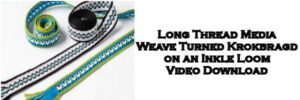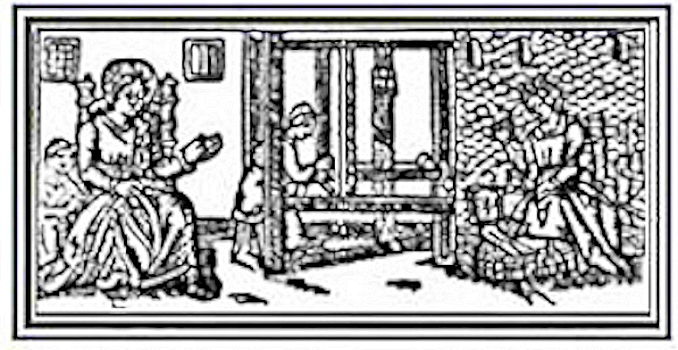Did you know that you can set up a simple bike odometer for use as a skein winder counter? For several years, I have struggled with keeping track of counting how many times to turn the skein winder in order to wind on a given length of yarn. Often I would lose track and have to start again, or recount the number of strands that have been wound on.
As I’ve been winding a lot of skeins lately in order to dye yarns, I decided to try and find a better solution to the counting and keeping track problem. Happily, I discovered that adapting a bike odometer will solve this problem. I purchased an inexpensive bike odometer from Amazon.
You can use the Distance counter on the bike odometer to keep track of the ‘distance’ or length of yarn that has been wound or has travelled around the skein winder. DST – Distance of Single Trip. Here’s how.
The bike odometer that I purchased has everything you need to get started:
Bike Odometer
Sensor
Magnet
Batteries
When you get your bike odometer, install the batteries as instructed. One goes into the odometer, and another goes into the sensor. You will need to calibrate the odometer to the circumference size of your skein winder (bike wheel)
Use a tape measure to determine the circumference of the skein winder. You probably know how much this is already since you wind and measure skeins already. But double check.
The bike odometer should work in both km and miles, but I find it easier to do the calculations in metric.
My skein winder has a 132 cm circumference or 1.320 meters.

Follow the instructions to calibrate the odometer. I set this to 1320.
Then attach the Magnet to one of the spokes on the skein winder. It’s best to put the magnet at one of the far ends of the spoke and not close to the centre. Then attach the Sensor to a fixed position like a table leg. This has to be quite close to the magnet, so that as the magnet passes by the sensor it picks up the movement. In the instructions for this bike odometer, the sensor/magnet distance has to be within 3 mm as it passes on its rotation.

Set the odometer so that it is ready to record. You will be using the DST setting. The reading that the odometer provides is the number of meters or kilometers that the bike wheel or skein winder has travelled, not the number of rotations. So this provides you with the number of meters of yarn that have been wound onto the skein.

In this example, I have wound on 150 meters of yarn onto the skein – 0.150 km on the DST reading.
Reset the DST reading back to zero every time you wind a new skein.
I tested this on several yarns by calculating how much I thought should be on the skein and comparing it to the weight of the skein.
For this yarn, it has a yardage of 3000 m/kg.
So a 50 gram skein of yarn should have a length of 150 meters.
I weighed the skein and it does weigh 50 grams.
An ongoing problem solved, without a lot of expense!
Handspinning Books
The Fleece and Fiber Sourcebook: More Than 200 Fibers, from Animal to Spun Yarn
The Whole Craft of Spinning: From the Raw Material to the Finished Yarn
The Practical Spinner’s Guide – Cotton, Flax, Hemp (Practical Spinner’s Guides)
Spin Flax & Cotton: Traditional Techniques with Norman Kennedy
The Alden Amos Big Book of Handspinning: Being A Compendium of Information, Advice, and Opinions On the Noble Art & Craft
The Knitter’s Book of Wool: The Ultimate Guide to Understanding, Using, and Loving this Most Fabulous Fiber
The Intentional Spinner
EBAY Handspun Art Yarns
HANDSPUN ART YARN – US
HANDSPUN ART YARN – UK
 LONGTHREAD MEDIA VIDEO
LONGTHREAD MEDIA VIDEO
 LONGTHREAD MEDIA SUBSCRIPTIONS
HANDWOVEN MAGAZINE
PIECEWORK MAGAZINE
SPINOFF MAGAZINE
LEARN LONGTHREAD MEDIA
PAIVATAR HANDMADE
LONGTHREAD MEDIA SUBSCRIPTIONS
HANDWOVEN MAGAZINE
PIECEWORK MAGAZINE
SPINOFF MAGAZINE
LEARN LONGTHREAD MEDIA
PAIVATAR HANDMADE
 Paivatar on YouTube
Visit my YouTube channel for how-to craft videos.
Paivatar on YouTube
Visit my YouTube channel for how-to craft videos.
Or Please visit my Channel on Rumble for more how-to videos.
https://rumble.com/Paivatar
LIVE STREAMS - Paivatar Studio
KICK
TWITCH MAKERS&CRAFTING
YOUTUBE
Categories: HAND SPINNING, Handspun Yarns, How To



